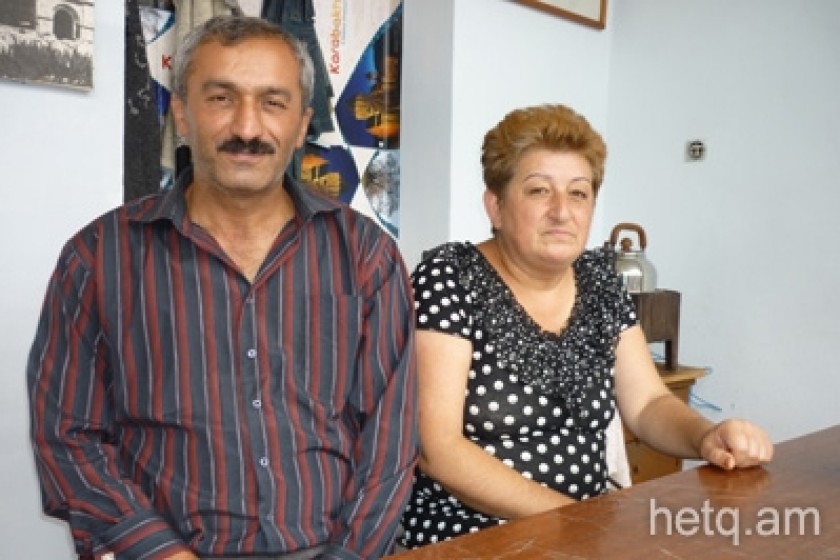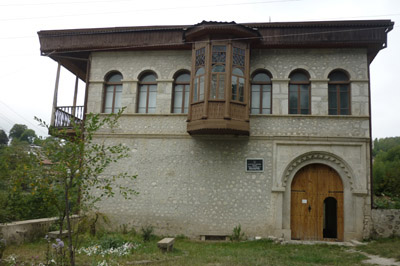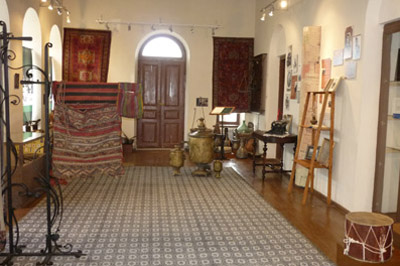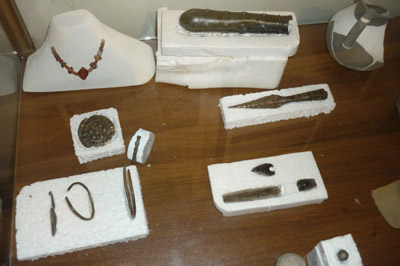
Shushi Museum: Much to Display but Running Out of Space
The only museum in the Artsakh town of Shushi goes by the unwieldy official name of the Historical-Geological Museum.
The building served as a maternity ward before the liberation of the town by Armenian forces in 1992. It was turned into a museum a few days later with a total collection of 500 items.
Today it has over 5,000 artifacts in its collection of which 413 are on display for visitors both Armenian and foreign.
But, it faces a number of problems. The museum is running out of space, there are no security cameras installed, there is no artifact repository and only one working computer.
Museum Director Ashot Harutyunyan brought the computer from home.
He and Roumela Hakobyan, the museum conservator, both hail from Shushi and take a special pride in their work.
There’s a fountain opposite the museum but the water suddenly stopped flowing about a two month ago. He complained and the pipes have been changed. Officials have promised that the water will flow once again.
Director Harutyunyan has requested that a pipe be installed that reaches the museum – just in case of a fire.
The museum building dates back to the 19century and is mostly made of wood.
 From 2005 to 2008, the Tufenkian Foundation allocated funds for renovation of the museum. A heating system was installed, the roof was replaced and the balcony repaired.
From 2005 to 2008, the Tufenkian Foundation allocated funds for renovation of the museum. A heating system was installed, the roof was replaced and the balcony repaired.
Most of the items at the museum have been collected locally, from Shushi area residents. The remainder has been from Yerevan.
Director Harutyunyan now says that residents are holding back from such donations, preferring instead to sell them on the open market.
For the past two years, the government’s Department of Tourism has allocated 200,000 AMD annually to cover the museum’s miscellaneous expenses.
Area residents still bring a variety of items to the museum for possible purchase but the director says they are mostly common items which the museum already has plenty of.
The way it works is that residents bring items to the museum and then it’s up to the Tourism Department to assess their value and whether or not they are suitable for purchase. The procedure is for the Department to make a decision within two weeks, not more.
Director Harutyunyan complains that oftentimes items are in the Department’s possession for months on end.
“Recently, someone from the village of Karintak brought in three items that had been unearthed there. We gave them to the Department and the stuff has been in their possession for over 3 months. I and some friends chipped in to buy the items, rather than wait for the Department to make up its mind. Now, I plan to go to Stepanakert and tell them to return those items to the museum. The poor man was coming to the museum every few days.”
 Director Harutyunyan believes that new items must now come from professionally organized excavations under the auspices of the National Academy of Sciences in Yerevan.
Director Harutyunyan believes that new items must now come from professionally organized excavations under the auspices of the National Academy of Sciences in Yerevan.
But he first the museum must receive the status of a research institute. Three of the museum’s nine staffers have degree in history and the director says they just need some retraining in the field.
Right now, the museum is under the jurisdiction of the Artsakh government’s Department of Tourism. Director Harutyunyan wants this to change.
“It’s absurd. Tourism has nothing to do with science. The Shushi Museum must be placed on a firm scientific footing,” the director argues.
There is talk that the government wants to place the museum back under the jurisdiction of the Ministry of Culture – the status it formerly had.
Director Harutyunyan believes such a move would usher in a bureaucratic maze of useless paperwork.
“Such a move will not solve our problems,” says the director, adding that he plans to go straight to the Academy and request that the museum be placed under its jurisdiction.
 He points out that there are 2,000 burial vaults on the Shushi plateau alone which have been plundered in the pre-Soviet period.
He points out that there are 2,000 burial vaults on the Shushi plateau alone which have been plundered in the pre-Soviet period.
Back in 2005, Professor Hamlet Petrosyan from the RA Archeological and Ethnographic Institute came to Shushi and conducted excavations in the area. He also set up an excavations working group in which Harutyunyan participated.
The group mapped out the burial sites and excavated a few dating back to the 8-10th centuries B.C.
Some of the artifacts they unearthed are now on display at the museum.
Director Harutyunyan says the Azerbaijani Academy of Sciences conducted excavations in a nearby cave back in 1974-1975.
“Supposedly, they found artifacts that were older still. They were taken back to Baku and put on display as being Caucasian Albanian (Aghvanq).”
 Videos
Videos Photos
Photos




Comments (1)
Write a comment